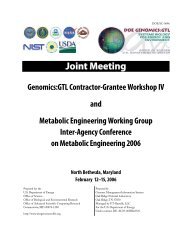Joint Meeting - Genomics - U.S. Department of Energy
Joint Meeting - Genomics - U.S. Department of Energy
Joint Meeting - Genomics - U.S. Department of Energy
Create successful ePaper yourself
Turn your PDF publications into a flip-book with our unique Google optimized e-Paper software.
10<br />
Systems Biology for DOE <strong>Energy</strong> and Environmental Missions<br />
3.<br />
4.<br />
and Enzymes for Bi<strong>of</strong>uels Production. Science 315,<br />
804-807.<br />
Xu Q., Arenkiel, P, Tucker, M. P., Ai, X., Rumbles,<br />
G., Sugiyama, J., Himmel, M. E., and Ding, S.-Y.<br />
Labeling the Planar Face <strong>of</strong> Crystalline Cellulose<br />
Using Quantum Dots Directed by Type-I Carbohydrate-Binding<br />
Modules. Cellulose, submitted.<br />
Ding, S. Y., Xu, Q., Ali, M. K., Baker, J. O., Bayer,<br />
E. A., Barak, Y., Lamed, R., Sugiyama, J., Rumbles,<br />
G., & Himmel, M. E. (2006) Versatile derivatives<br />
<strong>of</strong> carbohydrate-binding modules for imaging <strong>of</strong><br />
complex carbohydrates approaching the molecular<br />
level <strong>of</strong> resolution. Biotechniques 41, 435-443.<br />
This work is funded in part by the U.S. <strong>Department</strong> <strong>of</strong> <strong>Energy</strong>’s<br />
<strong>Genomics</strong>:GTL program under two projects, “DOE Bio<strong>Energy</strong><br />
Science Center” and “Study <strong>of</strong> Lignocellulosic Material Degradation<br />
with CARS Microscopy”.<br />
9<br />
Dynamic Visualization <strong>of</strong><br />
Lignocellulose Degradation by<br />
Integration <strong>of</strong> Neutron Scattering<br />
Imaging and Computer Simulation<br />
Barbara R. Evans 1 * (evansb@ornl.gov), Jeremy C.<br />
Smith, 2,3 Volker Urban, 1,4 Dean A. Myles, 1,4 William T.<br />
Heller, 1,4 Hugh M. O’Neill, 1 Art Ragauskas, 5 and Ida<br />
Lee 1,6<br />
1Chemical Sciences Division, Oak Ridge National<br />
Laboratory, Oak Ridge, Tennessee; 2Center for<br />
Molecular Biophysics, Oak Ridge National Laboratory,<br />
Oak Ridge, Tennessee; 3 Governor’s Chair, University <strong>of</strong><br />
Tennessee, Knoxville, Tennessee; 4Center for Structural<br />
Molecular Biology, Oak Ridge National Laboratory,<br />
Oak Ridge, Tennessee; 5Institute <strong>of</strong> Paper Science and<br />
Technology, School <strong>of</strong> Chemistry and Biochemistry,<br />
Georgia Institute <strong>of</strong> Technology; and 6<strong>Department</strong> <strong>of</strong><br />
Electrical and Computer Engineering, University <strong>of</strong><br />
Tennessee, Knoxville, Tennessee<br />
Project Goals: Lignocellulosic biomass is a complex<br />
material with a molecular-level morphology and<br />
laminate structure that result in its recalcitrance to<br />
deconstruction and subsequent enzymatic hydrolysis<br />
to fermentable sugars. The objective <strong>of</strong> this research<br />
project is the development <strong>of</strong> reliable real-time in situ<br />
imaging technology integrating the various neutron<br />
and simulation techniques to obtain detailed information<br />
on the relationship <strong>of</strong> atomic and mesoscale<br />
structure to resistance to hydrolysis in lignocellulosic<br />
* Presenting author<br />
GTL<br />
materials. This structural complexity will be elucidated<br />
by applying scattering techniques over a wide range <strong>of</strong><br />
length scales (Ångströms to micrometers using wide-,<br />
small- and ultra-small angle scattering) and using several<br />
complementary approaches to contrast variation,<br />
including x-rays with sensitivity to electron density<br />
and neutrons with sensitivity to isotope composition in<br />
combination with neutron contrast variation by using<br />
appropriate blends <strong>of</strong> hydrogenated and deuterated solvents<br />
as well as by specific isotope labeling <strong>of</strong> individual<br />
biomass components. This comprehensive and multiscale<br />
approach is necessary to address the complexity <strong>of</strong><br />
the multi-component, multi-length-scale and multiphase<br />
structure <strong>of</strong> lignocellulosic biomass.<br />
Lignocellulosic biomass is composed <strong>of</strong> plant cell walls.<br />
It is a complex material composed <strong>of</strong> crystalline cellulose<br />
micr<strong>of</strong>ibrils laminated with hemicellulose, pectin, and<br />
lignin polymers. Understanding the physical and chemical<br />
properties <strong>of</strong> this biomass is crucial for overcoming<br />
the major technological challenge in the development <strong>of</strong><br />
viable cellulosic bioethanol, the minimization <strong>of</strong> biomass<br />
recalcitrance to hydrolysis via the improvement <strong>of</strong> pretreatment<br />
and the design <strong>of</strong> improved feedstock plants.<br />
To address this problem, we propose to integrate neutron<br />
science, surface force recognition imaging, and computer<br />
simulation technology to provide in situ real-time<br />
multi-scale visualization <strong>of</strong> lignocellulose deconstruction.<br />
A full arsenal <strong>of</strong> neutron scattering techniques will be<br />
employed, ranging from diffraction through small-angle<br />
scattering and dynamic neutron scattering in combination<br />
with state-<strong>of</strong>-the-art high-performance computer<br />
simulation to achieve an understanding <strong>of</strong> the physicochemical<br />
mechanism <strong>of</strong> biomass recalcitrance in unprecedented<br />
detail. A key part is the design and employment<br />
<strong>of</strong> multipurpose neutron imaging chamber specifically<br />
designed for in situ dynamic observation under biomass<br />
pretreatment conditions. This visualization <strong>of</strong> biomass<br />
morphological degradation during heat, pressure, chemical<br />
or enzymatic treatment will provide fundamental<br />
molecular level information that will address the following<br />
basic questions:<br />
•<br />
•<br />
•<br />
•<br />
Visualization <strong>of</strong> regional transitions <strong>of</strong> cellulose<br />
between crystalline and amorphous.<br />
Investigation <strong>of</strong> lignin degradation and repolymerization<br />
in response to biomass pretreatment.<br />
Quantitative characterization <strong>of</strong> lignin associations<br />
with cellulose before, during and following<br />
heat, pressure, chemical or enzymatic treatment.<br />
Analysis <strong>of</strong> accessibility <strong>of</strong> bio-mass components<br />
to solvent molecules, chemical agents or enzymes





